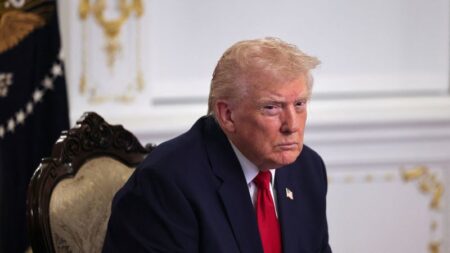In a significant policy shift, the Pentagon, as per a memo authored by Undersecretary of Defense for Policy Elbridge Colby last month, now has the option to redirect weapons and military equipment originally intended for Ukraine back into U.S. stockpiles. This change raises serious concerns about the implications it could have on the financial and military aid previously earmarked for Ukraine amidst its ongoing conflict with Russia, potentially diverting billions back to military reserves in the United States. This development comes at a time of heightened uncertainty regarding U.S. arms shipments to Ukraine, particularly with President Trump’s anticipated meeting with Russian President Vladimir Putin on the horizon.
Despite Trump approving a plan to sell U.S. weapons to Ukraine via NATO, serious apprehensions persist within the Pentagon regarding the ramifications of providing arms to Kyiv, especially given that U.S. military stockpiles are currently under significant strain. This concern is acutely centered around critical military components such as interceptor missiles, air defense systems, and artillery ammunition, which are in dangerously low supply. In line with these considerations, Defense Secretary Pete Hegseth had previously halted a large shipment of weapons to Ukraine, adhering to the guidelines set in the Colby memo. Colby, known for his cautious stance towards military support for Ukraine, has influenced this potential alteration in policy.
In a swift reversal of Hegseth’s decision, Trump reaffirmed his commitment to supplying defensive weapons to Ukraine after Russia intensified its military aggression. The Trump administration also struck a potential deal with NATO to provide more military support to Ukraine, where U.S. production meets European funding, enabling a pathway for increased support to Kyiv without straining American resources.
The Colby memo introduces a previously unreported provision permitting the Pentagon to reclaim weapons designated for Ukraine through a program known as the Ukraine Security Assistance Initiative (USAI). This program, created to secure funding for the acquisition of military equipment directly from U.S. manufacturers, has been pivotal in ensuring a steady stream of military assistance to Ukraine. However, the newly updated guidelines raise questions regarding the extent to which allocated funds will actually benefit Ukraine, especially as concerns over stockpile depletion grow.
Congress, under previous administrations, viewed the diversion of weapons produced under the USAI program back into U.S. stockpiles as potentially infringing upon the Impoundment Control Act. This act necessitates presidential notification to Congress regarding any delays or withholding of funds legally authorized for distribution. As a response to the irrevocable policy shift, recent legislative efforts have emerged in the Senate to establish stricter controls that would prevent the Pentagon from recalling stock until it has been determined that these items are surplus and no longer crucial for Ukraine’s defense.
At the core of the ongoing discussions is a broader narrative of increasing reliance on European NATO allies to share the burden of supplying Ukraine with arms and equipment. Colby has previously advocated for the retention of U.S. military stockpiles in anticipation of future conflicts, particularly regarding potential tensions with China. Meanwhile, the Pentagon is in a delicate position, with nearly $4 billion in advanced funding remaining available for direct weapon supplies to Ukraine from American stockpiles. Several NATO allies encourage the use of these available resources to maintain pressure on Russia, proposing reimbursement schemes for expenses incurred through these requirements.
In a concerted effort to fund military provisions for Ukraine, Senate leaders recently proposed establishing a U.S. Treasury fund into which NATO allies could contribute, essentially backfilling U.S. military equipment donated to Ukraine. However, despite these initiatives, there is skepticism surrounding the Pentagon’s willingness to expend the remaining funding authority.
The classification of stockpiles under the Colby memo into tiered categories indicates a clear intent to prioritize military resources. With weapons in the “red” category requiring explicit signoff before repurposing, the focus remains on ensuring that essential arms, such as interceptor missiles vital for national defense systems, continue flowing to Ukraine amid the persistent Russian offensive.
The situation remains fluid, as Ukrainian officials have consistently downplayed U.S. concerns about depleting military reserves, while the Biden administration has also cited similar reservations regarding arms deliveries. As the conflict intensifies, the need for advanced air defense systems to combat the ongoing aerial assaults by Russia has never been more pressing, with reports of unprecedented missile attacks highlighting the urgency of military support.
In the larger context, the Pentagon’s collaboration with NATO aims to establish innovative mechanisms for weapon sales, establishing a NATO fund that enables allies to finance military acquisitions directly from the U.S. This new model seeks to allow Ukraine to put together lists of necessary equipment, with these requests being assessed by U.S. military officials to ensure adequate stock levels before engaging European partners for potential purchases.
As discussions continue, the commitment from NATO allies to fund arming efforts remains intact, as demonstrated by their significant pledges supporting Ukraine in its ongoing struggle. These transformative policy dynamics amidst geopolitical tensions will profoundly shape the military landscape moving forward, underlining the necessity for strategic planning and international cooperation in military support initiatives











